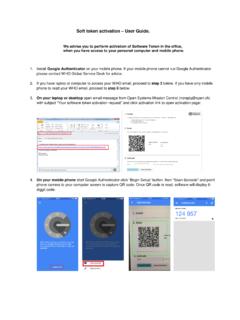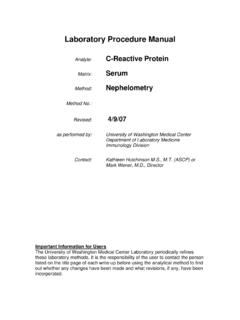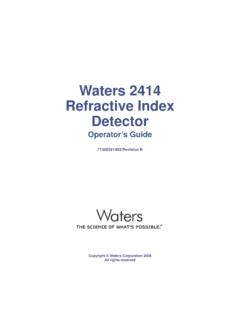Transcription of Annex : Calculation of Mean and Standard Deviation
1 quantitative QC Module 7 Annex 1 Annex : Calculation of Mean and Standard Deviation A cholesterol control is run 20 times over 25 days yielding the following results in mg/dL: 192, 188, 190, 190, 189, 191, 188, 193, 188, 190, 191, 194, 194, 188, 192, 190, 189, 189, 191, 192. Using the cholesterol control results, follow the steps described below to establish QC ranges. An example is shown on the next page. 1. Make a table with 3 columns, labeled A, B, C. 2. Insert the data points on the left (column A). 3. Add Data in column A. 4. Calculate the mean: Add the measurements (sum) and divide by the number of measurements (n). N 20 5. Calculate the variance and Standard Deviation : (see formulas below) a. Subtract each data point from the mean and write in column B. b. Square each value in column B and write in column C. c. Add column C. Result is 71 mg/dL. d. Now calculate the variance: Divide the sum in column C by n-1 which is 19.
2 Result is 4 mg/dL. e. The variance has little value in the laboratory because the units are squared. f. Now calculate the SD by taking the square root of the variance. g. The result is 2 mg/dL. Mean= x1 +x2 +x3+.. xn 3809 = mg/dL quantitative QC Module 7 Annex 2 A B C Data points. X1-Xn 192 mg/dL mg2/dL2 188 mg/dL mg2/dL2 190 mg/dL mg2/dL2 190 mg/dL mg2/dL2 189 mg/dL mg2/dL2 191 mg/dL mg2/dL2 188 mg/dL mg2/dL2 193 mg/dL mg2/dL2 188 mg/dL mg2/dL2 190 mg/dL mg2/dL2 191 mg/dL mg2/dL2 194 mg/dL mg2/dL2 194 mg/dL mg2/dL2 188 mg/dL mg2/dL2 192 mg/dL mg2/dL2 190 mg/dL mg2/dL2 189 mg/dL mg2/dL2 189 mg/dL mg2/dL2 191 mg/dL mg2/dL2 192 mg/dL mg2/dL2 x=3809 = -1 Sum of Col C is 71 mg2/dL2 The square root returns the result to the original units.
3 The sum of the squared differences of each value from the mean (column C) is 71. Notes: a) In the calculations for variance, n-1 is used rather than n. This has been shown to reduce bias and provide a more true measure of variation. Therefore, for 20 data points, n-1 = 19. b) S2 is the variance, SD is the square root. xxi ()2ixx ()2ixx mg/dLSSD21n)X(X2i ==dLmg/219/71 SSD2=== quantitative QC Module 7 Annex 3 Calculate the Ranges The mean of these data is , and the SD is 2. To calculate the acceptable ranges for use in quality control decisions: 1. Range for 1 SD: Subtract the SD from the mean ( 2 = ) Add the SD to the mean ( + 2 = ) Range for 1 SD is - 2. Range for 2 SD: Multiply the SD by 2 (2 x 2 = 4) Add and subtract 4 from the mean ( ) Range for 2 SD is - 3. Range for 3 SD: Multiply the SD by 3 (2 x 3 = 6) Add and subtract 6 from the mean ( ) Range for 3 SD is Next make Levey-Jennings charts by plotting the mean and SD.
4 See content sheets 7-4 and 7-5 for details.










